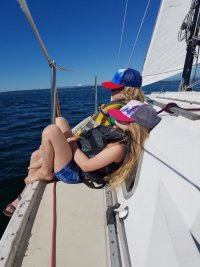We had another great weekend on the boat. We spent Saturday night at anchor a few miles from our slip then stopped for the day on Sunday at Langley where we met up with some friends (socially distanced, which was a little awkward, but well work it).
The wind instruments have never worked, but I’m guessing it was 15 to 20 knots both days. Waves were 2 to 3 feet with some white caps and a small wind ripple on top. No spray and we stayed dry both days with just an occasional splash on deck. As luck would have it, we found ourselves with the wind at the beam or behind us both days. I don’t have a preventer rigged and the main is a little difficult to hoist, so I decided to sail with the 120 headsail only. On the beam reach, we were cruising at 6 knots with a few moments up around 7. I am blown away by how well the boat sailed in this configuration. There was a slight weather helm, just enough to feel the rudder on the beam reach. Downwind, it was balanced and easy to handle hovering around 5.5 knots.
I am confused why there wasn’t Lee helm without the main and why, in my limited experience with the boat, there isn’t excessive weather helm with the main up. By no means am I complaining, but I’ve been spending a lot more time focusing on balancing the boat as opposed to trimming the sails independently and this seems to go against what I’ve learned and experienced to this point. Is the center of effort for each sail just perfectly placed above the center of resistance of the keel? Would this move back and cause lee helm if I had a larger head sail? What do other 32, 35, and 38 owners run on their furlers?
The wind instruments have never worked, but I’m guessing it was 15 to 20 knots both days. Waves were 2 to 3 feet with some white caps and a small wind ripple on top. No spray and we stayed dry both days with just an occasional splash on deck. As luck would have it, we found ourselves with the wind at the beam or behind us both days. I don’t have a preventer rigged and the main is a little difficult to hoist, so I decided to sail with the 120 headsail only. On the beam reach, we were cruising at 6 knots with a few moments up around 7. I am blown away by how well the boat sailed in this configuration. There was a slight weather helm, just enough to feel the rudder on the beam reach. Downwind, it was balanced and easy to handle hovering around 5.5 knots.
I am confused why there wasn’t Lee helm without the main and why, in my limited experience with the boat, there isn’t excessive weather helm with the main up. By no means am I complaining, but I’ve been spending a lot more time focusing on balancing the boat as opposed to trimming the sails independently and this seems to go against what I’ve learned and experienced to this point. Is the center of effort for each sail just perfectly placed above the center of resistance of the keel? Would this move back and cause lee helm if I had a larger head sail? What do other 32, 35, and 38 owners run on their furlers?


